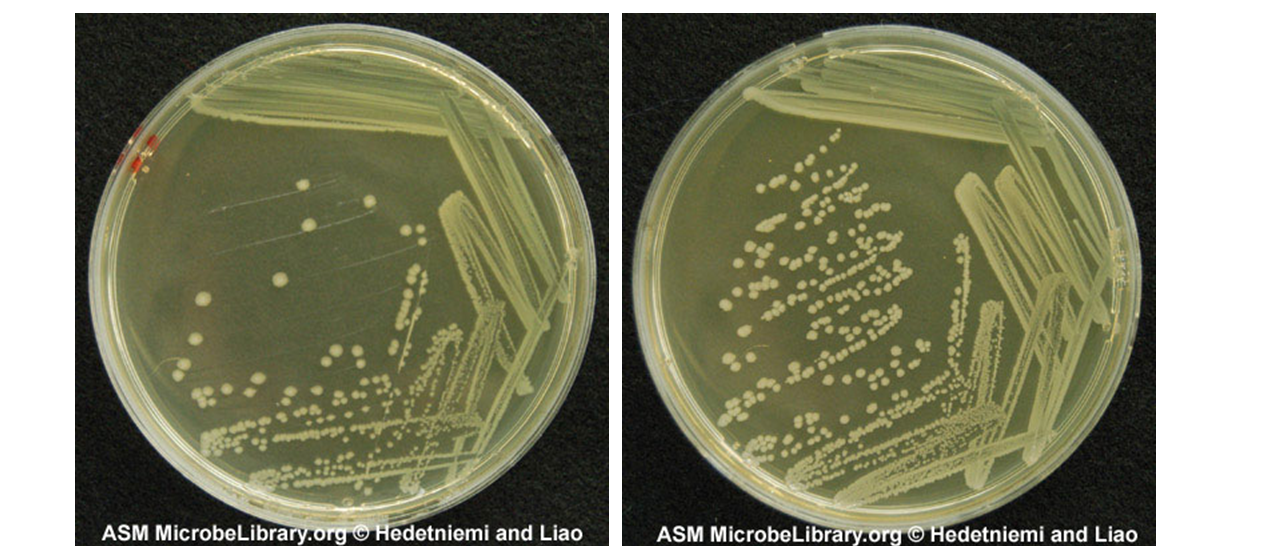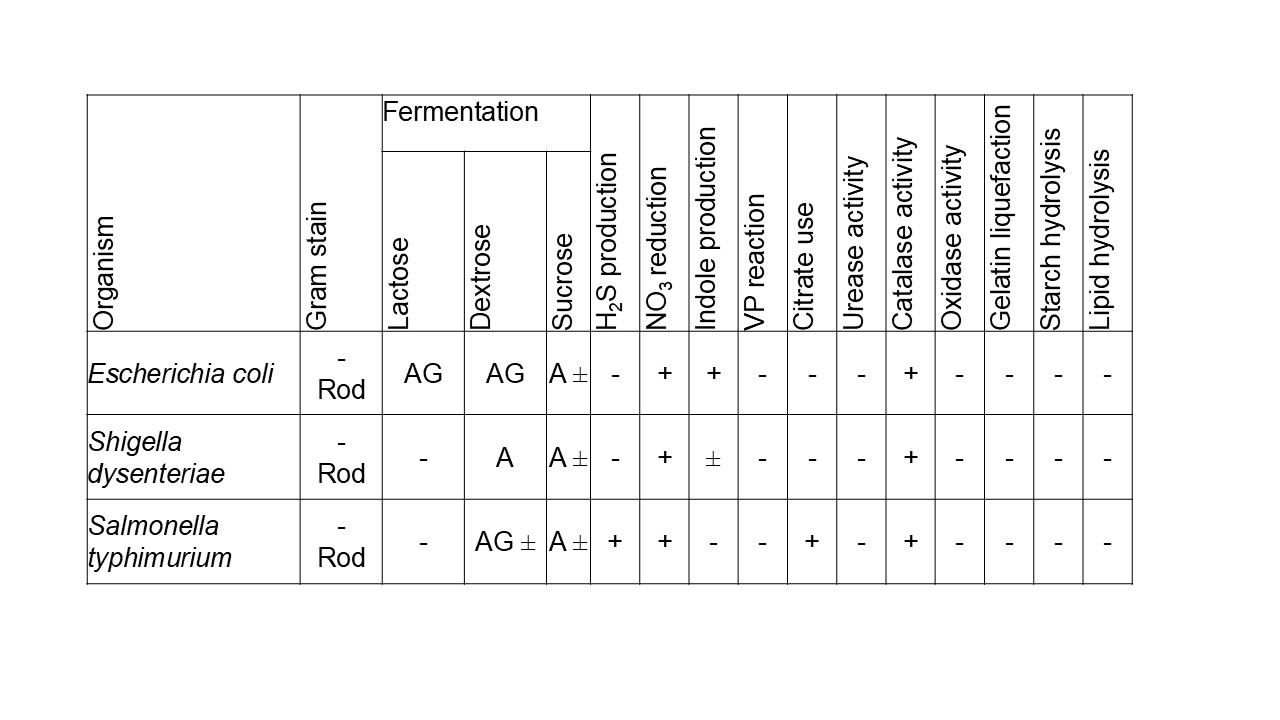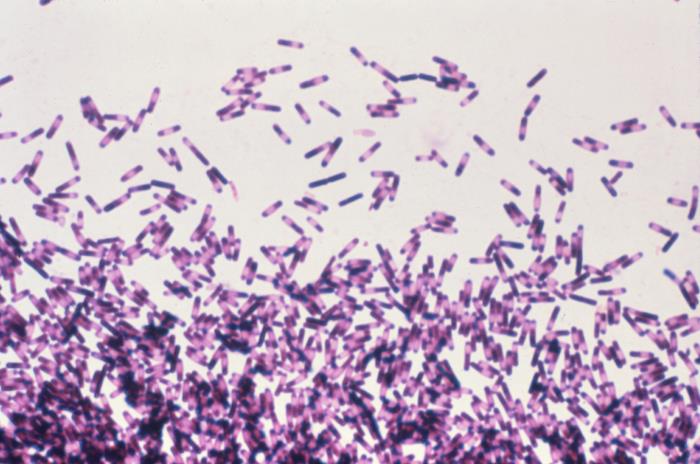24 Identification of Intestinal Pathogens
24.1 Identification of Intestinal Pathogens
There are a number of different pathogens that can infect the intestinal tract, including bacteria, fungi, protozoa, and viruses; however, we will only be considering the enterobacteria and the clostridia in this lab. Intestinal pathogens such as these can cause diseases which range from rather mild, self-limiting infections, to those which have much more serious consequences.
Remember that it is important, in most identification methods, to first isolate the unknown in axenic culture (Section 9.1), and that the intestinal microbiome (gut flora) of humans is generally quite complex - thus, identifying a particular pathogen from a clinical sample (e.g. a faecal sample) can be sometimes challenging.
The techniques discussed here for identification of enterobacteria are useful for clinical diagnoses, but are also more broadly applied in public health/water monitoring - for example, coliform counts are used to monitor water quality/the presence of faecal contamination in waterways.
24.1.1 Identification of enterobacteria
Pathogenic enterobacteriaceae like Salmonella, Shigella, and Escherichia are all relatively closely related, and they share a number of common characteristics – they are Gram-negative rods, non-spore-forming, facultative aerobes.
Indeed, if you were to streak these three organisms on nutrient agar, or LB1 agar, you would find that all three produce colonies with very similar morphologies (Figure 24.1). Likewise, a Gram stain would not be able to distinguish between these different organisms.

However, these organisms can be distinguished from one another by molecular methods or based on a number of biochemical tests, as can be seen in Figure 24.2.

In this lab, we will be using differential media (Section 25.1.1) and an API-20E test (Section 26.1) to identify an unknown enterobacterium (Case Study 3). Which other tests/experiments could you perform?
The epidemiologists have linked a sudden outbreak of diaorrheal diseases to a particular batch of frozen spinach, but the aetiological agent has not yet been confirmed.
You are working as a microbiologist with the Food Standards Agency, which is looking into the case. You suspect that it may be one of the common culprits – E. coli, Salmonella, or Shigella – but you need to figure out which.
A small portion of the spinach was homogenized and plated out on non-selective nutrient agar, and isolated colonies then grown in pure culture.
Your task is to determine whether the isolated pathogen is E. coli, Salmonella, or Shigella using selective and differential media (Task 3A), and an API-20E strip (Section 26.1).
24.1.2 Identification of clostridia
Most clostridia are Gram-positive, endospore-forming, obligate anaerobes, and some are pathogenic to humans. Clostridioides difficile (sometimes still called Clostridium difficile) can cause serious infections in the intestine, particularly when the gut microbiome is perturbed (e.g., by antibiotic treatment). (Note in the endospores in Figure 24.3 (here seen as paler regions in the stain - endospores can also be visualised by differential stains.))

You may recall that in first year, you identified some isolates of Clostridium spp. using 16S rRNA sequences (the BM110 Montrose Murders case). In that case, we were investigating the possibility that Clostridium botulinum isolates had been used to produce the toxin involved in the murder.
Other well-known pathogenic clostridia include Clostridium tetani (tetanus), and Clostridium perfringens (gas gangrene, and food poisoning).
In this lab, we will be using biochemical tests, and studying the ability to grow aerobically/anaerobically, to determine whether an unknown organism is likely to be Escherichia coli or C. difficile (Case Study 4). Which other tests/experiments could you perform? How could you make a definitive identification?
CASE STUDY 4. The case of the careless clinician.
You are working in a clinical microbiology with a friend, who has just left for holiday – leaving you to record the results from the last sample he was processing. You think he said that it was C. diff– or maybe E. coli – he was definitely working on faecal samples earlier that morning. But you aren’t entirely sure and he isn’t answering his phone. (You need to get better friends.)
The patient can’t wait for a diagnosis until your friend gets back from his holiday, so you’d better figure it out for him. Your task is to determine whether the isolated pathogen is Clostridium or E. coli using biochemical assays (Task 3B) and by testing whether the pathogen is an obligate or facultative anaerobe (Task 3C).
Lysogeny Broth↩︎